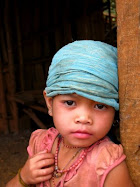
On Amantani Island in Lake Titicaca, life goes on much like it has for thousands of years. No roads, no vehicles, and in fact, I never saw a wheel of any type. A few buildings have lights running off car batteries, but mostly people use candle light. The island is covered with terraced garden plots, where people grow herbs, many kinds of potatoes and other root vegetables, peas, beans, and a variety of grains. They catch fish from the lake also, but only small ones now. The villagers told us that the big fish disappeared a while ago. They also grow small stands of Eucalyptus trees for firewood. There are a few animals on the island, some cows, sheep and guinea pigs. These are used for dairy, wool, and sale, respectively. The islanders do not have dogs, "except for four," as they made an agreement, followed by most of the villagers, that they didn't want dogs because they are loud and bother the children.
We stayed two nights on the island with Captain Gabriel, his wife, four daughters, and son. During the day, Gabriel worked in the fields, while his wife and children (after school) sorted through the harvest and wove textiles. Weaving is an integral part of the culture and it is common to see women spinning thread on a drop spindle when they walk, sit, or any time they have their hands free. Men knit wool hats with intricate designs and Gabriel used a sewing machine to make embroidered traditional head cloths for sale to the local women. The culture on the island seems more egalitarian than many places we have visited, especially in Asia. I saw both men and women working equally in the fields and in the home. Both carry heavy loads on their backs. Women inherit and seem to have more say in things than many women around the world.
Gabriel told us how his ancestors have lived on the island for 1000's of years, but it has more population now than ever before. People are having problems growing sufficient crops on their plots of land, which get smaller with each passing generation. Land is passed down equally to both sons and daughters, and Gabriel is worried about what will happen when his land must be split five ways between his children. It is now just enough to sustain them, he tells us. One of the consequences of having the land split equally between sons and daughters is that the land owned by a family becomes very fragmented as people from across the island marry. Gabriel and his family have many small plots of land spread out over the entire island. This same land has belonged to his ancestors and been passed down in his family for 1000's of years.
The family, and others on the island, combat this dilution of land by spreading out their economy to gain extra income. In addition to tourism, they sell guinea pigs for human consumption and small fish as trout food to the fisheries on the mainland. They sell woven, knitted, and embroidered textiles, locally and on the mainland, and even stone from the island quarries is carved into sinks and other objects to sell. Also, many people, especially the younger ones, are leaving the island to work in the cities. In addition to sending money home, this also results in land sometimes being available for purchase by other islanders.
There are two old temples at the top of the island. Even though the islanders are now officially Catholic, like most of South America, they still retain some of their ancient religious beliefs. Gabriel told us that the two temples are dedicated to Father and Mother Earth. In January, a dance is conducted between the two temples and sacrifices offered for a good harvest. On our second night, the weather grew stormy, with thunder and lightning off in the distance. We heard explosions of some type and asked Gabriel about them. "The villagers are scaring away the hail," he answered. "Big hail sometimes comes and damages the crops. The harvest is not finished." We think it was fireworks being lit, as Gabriel told us that the villagers do not have guns. "We do not need them. It is peaceful here" he explained.
From an environmental standpoint, the visit to the island was very interesting. Life is much the same here as at has been for thousands of years, and it is a good example at how people in a small system have dealt with their environment and the problems that have come, especially now with a swelling population. The entire island is used for agriculture, raising animals, growing trees for firewood, and placing homes and other infrastructure. Not one inch is left wild. For the most part, use of the land has been sustainable, with exception of the fish, which has been over fished to depletion of all large fish species. The problem of deforestation has been solved by planting trees for firewood. Although there is some erosion, it is mostly kept under control by the terracing system that covers the whole island. It remains to be seen whether the problem of overpopulation here, like most of the world, can be dealt with in a sustainable way.
Gabriel's Wife

Gabriel's youngest children in their traditionally styled hats. The villagers no longer use natural dyes, instead preferring the bright colors of chemical dyes.

A woman spinning

Colorful skirts out to dry

Herding sheep

Villagers can often be found spending siesta in the village square

A village women helps untie our boat

Heading home from the fields








1 comment:
Hound dog says more land less children.
Post a Comment